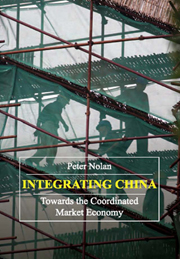Book contents
- Frontmatter
- Contents
- Acknowledgements
- Foreword
- 1 Reflections on 4th June 1989
- 2 The Global Business Revolution and Developing Countries
- 3 The Globalisation Challenge and the Catch-up of Developing Countries: The Case of the Brewing Industry
- 4 The Global Industrial Consolidation and the Challenge for China: The Case of the Steel Industry
- 5 China in the Asian Financial Crisis: ‘Cutting the Trees to Save the Forest’
- 6 China at the Crossroads
- 7 Capitalism and Freedom: The Contradictory Character of Globalisation
- 8 Capitalism, Conflict and Cooperation: US-China Relations under Capitalist Globalisation
- Index
4 - The Global Industrial Consolidation and the Challenge for China: The Case of the Steel Industry
Published online by Cambridge University Press: 05 March 2012
- Frontmatter
- Contents
- Acknowledgements
- Foreword
- 1 Reflections on 4th June 1989
- 2 The Global Business Revolution and Developing Countries
- 3 The Globalisation Challenge and the Catch-up of Developing Countries: The Case of the Brewing Industry
- 4 The Global Industrial Consolidation and the Challenge for China: The Case of the Steel Industry
- 5 China in the Asian Financial Crisis: ‘Cutting the Trees to Save the Forest’
- 6 China at the Crossroads
- 7 Capitalism and Freedom: The Contradictory Character of Globalisation
- 8 Capitalism, Conflict and Cooperation: US-China Relations under Capitalist Globalisation
- Index
Summary
Introduction
Mainstream View
The ‘mainstream’, ‘neo-classical view of the competitive process believes that the perfectly competitive model best describes the essence of capitalist competition. Departures from it are viewed as exceptional. In this view, there are limitless opportunities for firms from developing countries to ‘catch-up’; if they are forced into competition on the free market of the ‘global level playing field’. At the heart of the mainstream view is the self-equilibrating mechanism of market competition. It is believed that the basic driver of the capitalist process, competition, ensures that if any firm enjoys super-normal profits rivals will soon enter to bid away those profits and undermine any temporary market dominance that the incumbent enjoys. The neo-classical approach emphasises the importance of competition among small firms as the explanation for the prosperity of the advanced economies. Milton Friedman, for example, believes that there is ‘a general bias and tendency to overemphasize the importance of the big versus the small’ (Friedman, 1962: 120–3).
Mainstream economists argue that managerial diseconomies of scale set in after firms reach a certain size. The classic expression of this view was contained in Marshall's Principles of Economics (1920: 315-6), in which he likens the competitive process to the ‘trees in the forest’. The forest canopy never grows above a certain height. Large trees eventually lose their vigour and are replaced by newcomers: ‘[I]n almost every trade there is a constant rise and fall of large businesses, at any one moment some firm being in the ascending phase and others in the descending.
- Type
- Chapter
- Information
- Integrating ChinaTransition into Global Economy, pp. 71 - 94Publisher: Anthem PressPrint publication year: 2007



